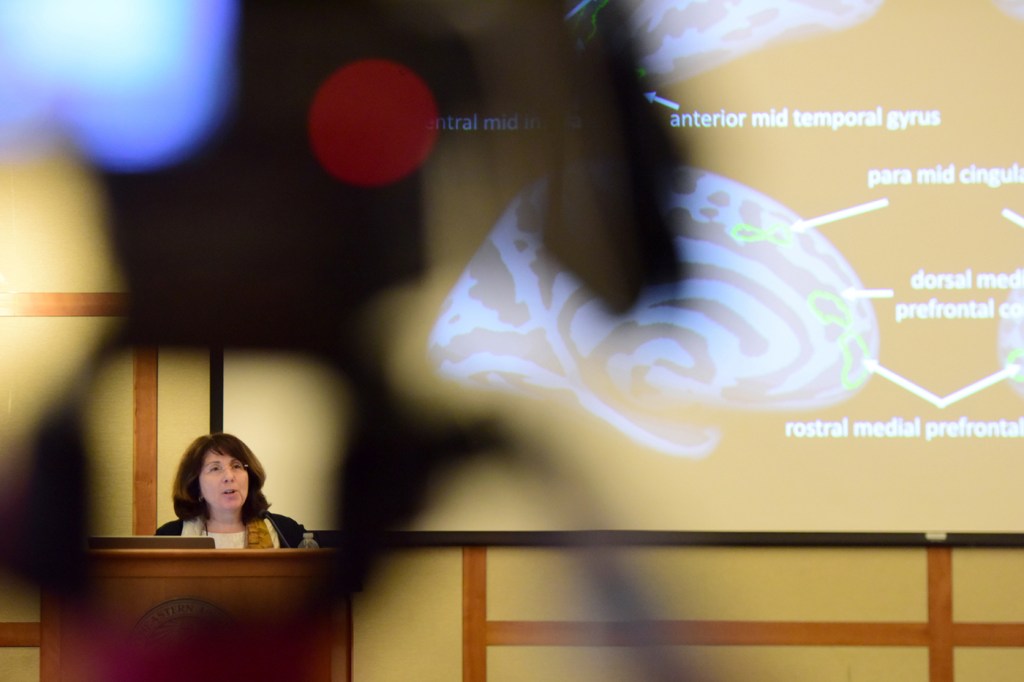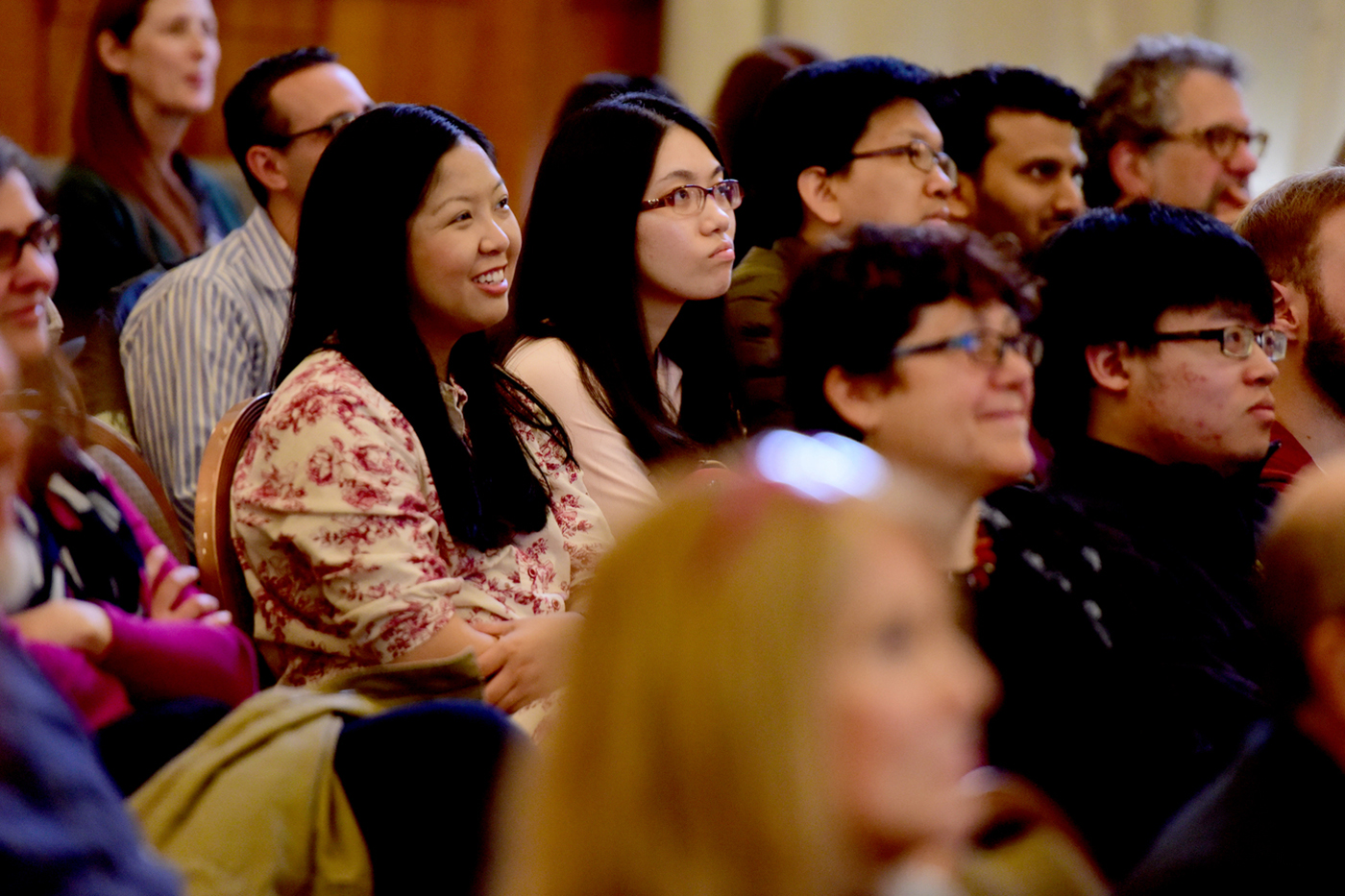Healthy aging: Can we turn back time?

“The Interdisciplinary Healthy Aging Initiative brings together stakeholders both within the university and outside in an effort to deal with healthspan—we’re not really interested in lifespan per se,” said Jon Tilly, University Distinguished Professor and chair of the Department of Biology at Northeastern. “We’d all love to live longer. What makes the IHAI effort unique is we want to achieve true healthcare, which is proactive, and not what we’re doing today, sick care, which is reactive.”
Tilly was introducing the first event sponsored by the initiative, a talk featuring three Northeastern researchers and titled “Improving Healthspan: The Science of Healthy Aging,” which took place on Monday in the Curry Student Center Ballroom.
A joint effort of the College of Science and the Bouvé College of Health Sciences, the initiative draws from the work of researchers, practitioners, technology leaders, and community and government representatives to transform care for older adults at both the policy and clinical levels.
Monday’s event focused on new findings in reproductive biology, the science of human movement, and the neuroscience of superagers.
Rejuvenating tissue function
Dori Woods, assistant professor of biology, studies ovarian aging and function in an effort to help ameliorate the many health complications of menopause, including increased risk for cardiovascular disease, osteoporosis, and depression. “The ovaries are going to fail due to aging,” said Woods. “This will happen to all women given our current technology.”
What makes the initiative unique is we want to achieve true healthcare, which is proactive, and not what we’re doing today, sick care, which is reactive.
John Tilly
University Distinguished Professor
After walking the audience through a primer on ovarian function in mammals, Woods described her research, in which she uses novel technologies to delay or prevent ovarian failure caused by aging or disease.
The technologies break new ground in rejuvenating tissue function. One uses ovarian stem cells to build ovarian follicles—the sacs in the ovaries comprising the egg, or oocyte, itself and the cells producing sex hormones such as estrogen. Another involves injecting mitochondria, the powerhouse of the cell, into poor-quality eggs. During in vitro-fertilization treatment, this translates into transplanting the mitochondria derived from a woman’s pristine, yet-to-develop egg stem cells directly into her older, already formed eggs, in an effort to reverse the aging process.
“How does this bolus of oocyte stem cell mitochondria change the course of fertility outcomes?” asked Woods. “This technique has been performed a number of times clinically, and the early success rates indicate that women now are having success with IVF where previously they weren’t.”
“Basic research is crucial”
Dagmar Sternad, professor of biology and electrical and computer engineering, focused her talk on developing, improving, and restoring motor function. She opened with a video clip of a ballerina in Swan Lake, an example of impeccable motor function, contrasted with a photo of the late actor Christopher Reeve, in a wheelchair, after the accident that left him a quadriplegic. These were just two of the images she used to illustrate motor capabilities and loss through the trajectory of neurological development, trauma, and disease.
Her research “begins with the challenge of understanding how the brain controls movement and continues with figuring out what we can do if something goes wrong.”

Three Northeastern researchers spoke to a packed audience in the Curry Student Center Ballroom about “Improving Healthspan: The Science of Healthy Aging.” Photo by Matthew Modoono/Northeastern University
In one study, Sternad used a pulse oximeter to measure motor activity in preterm infants in the hospital, performing time series analyses to understand their breathing patterns to predict and preempt sleep apnea. In another, she investigated how people perform polyrhythmic movements to understand how we learn and retain patterns. “The subjects have 20 sessions of practice in the lab,” she said. “When we bring them back in six months, and then eight years later, they can still perform the movements. How do we do that?”
A collaboration with researchers at the Massachusetts Institute of Technology focuses on developing robotic assistance for people who have suffered strokes and other brain injuries to help them walk again. The automated device straps on the ankle and facilitates the rhythmic movement of forward walking. “Basic research is crucial to developing these tools,” she said.
Feeling bad can be good
Lisa Feldman Barrett, University Distinguished Professor of Psychology, began her talk by listing some scientific myths, including the belief that the world was flat.
“In aging there are fairytales, too, one of which is the idea that memory declines with age,” said Barrett, author of a new book titled How Emotions are Made: The Secret Life of the Brain. “The brain is supposed to atrophy with age.”
In aging there are fairytales, too, one of which is the idea that memory declines with age.
Lisa Feldman Barrett
University Distinguished Professor
That’s not necessarily so, according to research she is conducting with scientists at Massachusetts General Hospital. “We have identified a group of superagers,” she said. “Their memory and attention isn’t merely above average for their age, but it actually is on par with healthy 25-year-olds. We want to understand superaging as a model for healthy aging.”
Through a series of experiments using functional magnetic resonance imaging, or fMRI, the team learned how feeling or emotion contributes to memory maintenance as people age. They compared the brains of the superagers to those of typical elderly people and young adults, and found that the volume of the hippocampus, a brain structure important in memory, was the same in the superagers and the young people (it was thick and highly functional) but attenuated in the typical elderly people. They have also found heightened activity, she said, in brain regions associated with “tenacity, or the ability to maintain effort in the face of discomfort,” in the young adults and the superagers when they performed a memory task but not in the typical elderly subjects.
“We live in a culture that promotes happiness,” said Barrett. “As people age, they show a tendency toward shunning activities they fear are unpleasant to maximize feeling good. But sometimes feeling bad is good for you.” For example, research has shown that mental effort and exercise can improve cognitive functioning.
“The road to superaging, we believe, is paved with a bit of discomfort now and then,” she said. “If you work through that temporary unpleasant feeling, the payoff may be a more youthful brain and a sharper memory.”





